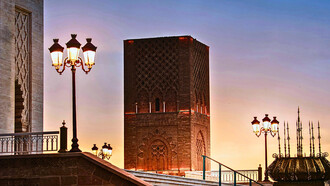Many visitors from the West and Mainland India still nurture tales of dreadfulness of visiting India’s Northeast – mountainous terrain, poor connectivity and virgin unexplored geography, little realizing that by overlooking India’s Northeast they lose a God-given opportunity to experience a totally diverse and exciting side of India. This region remains an enigma – dramatic landscape, exotic cuisine and the fascinating tribal culture is the stuff of fables.
Yeah, I am talking about Arunachal Pradesh and any mention of Arunachal Pradesh rekindles memories of my childhood days spent in unfretted and no-holds-barred rendez-vous in the company of my tribal Monpa friends. Winters were always very special and we took to the game of playing “football – on – ice”, much to the consternation of my possessive Mom.
I can still vividly recall my school holidays. Every day I and my younger brother would wake up early in the morning with my mom dressing us up with lots of heavy woolens, including the indigenously produced “Alipuddum Jacket” and after breakfast, it was time to go playing hide and seek with our Monpa friends.
Geographically speaking Arunachal Pradesh is positioned in the Eastern Himalayan province, which incidentally happens to be one of the richest bio-geographical prefectures of the Himalayas. The topography of the state is conspicuous by its complex hilly arrangement and the altitude varies from 50 meters in the foothills that progressively ascend to heights of 7000 meters and is crisscrossed by numerous swift-flowing rivers and rivulets. Leaving civilization behind, you only need to have your adrenalin surcharged and embark on a flight to Dibrugarh Airport in the neighbouring state of Assam, from where Pasighat (where Abor Country is located) is an exhilarating three-hour’s drive away.
The first impressions that you have upon entering the Resort premises are one of utter seclusion and that too in the lap of pristine nature – no honking of horns, no urban rat race and no trace of cutthroat competition. The manner in which this outstanding Eco-Lodge has showcased the rich tribal vernacular architecture of India’s Northeast as well as curating exceptional mountain/tribal tours deserves nothing less than a standing ovation if you take into account the region’s remoteness from Mainland India.
The man behind this epic adventure is Oken Tayeng who is credited for introducing high-end Luxury & Expedition-style tourism to India’s Northeast. The initial days were tough, much like the mountainous terrain – unpredictable. Oken’s only password was the stunning, diverse and unspoiled panorama. His deep belief that “Nature’s Grandeur” would one day be appreciated and true to his everlasting faith in mother nature, Abor Country is today a pioneer when it comes to experiencing India’s Northeast.
The resort has received global recognition for excellence - Nat Geo Traveller, Lonely Planet, Conde Nast Traveller, Outlook Traveler India have all featured Abor Country exclusively and with great in depth travel reportage. The US NAVY to has issued a “Certificate of Appreciation.
The beauty of Abor Country is heightened tremendously by the fact that it is set on the edge of the sparkling River Siang – one of India’s legendary rivers that traverses all of 2000 km. from the Tibetan plateau. Flowing through the mighty Himalayas, the Siang merges with Yamne, Lohit and Dibang as it ultimately empties into the mighty Brahmaputra.
Siang is no ordinary river and rafters find it just too exciting, what with all those countless rapids and deep gorges. The ingenuity of Abor Country is in full display at the annual rafting expedition – The Siang Rush that offers a golden opportunity to skilled rafters to test their rafting skills. No wonder, many prospective visitors try to customise their trip to Abor Country during this exciting Siang Rush festival.
The best thing about Abor Country is their stress on local vernacular architecture – the insistence is on locally available bamboo, wood and cane that creates an ambience that’s truly Asian. Each room is beautifully appointed and the soft feel of bamboo lends an aura of opulence and Abor Country has shown that in our efforts to protect planet earth, you do not need to sacrifice on style. Did you know that bamboo wood offers a far greater tensile strength than even steel? Out here at Abor Country, wooden dustbins are the norm and lamps made of fishing nets emphasize the rich flora and fauna of India’s Northeast.
Northeast India is a biodiversity hotspot and first-time visitors can look forward to some of the most stunning landscape formations ranging from the majestic Himalayan mountains to the grasslands. The fact that much of the region is forested, comes as a boon to visitors who would want to have a date with some of the stunning wildlife species – the unicorn Rhinoceros for instance.
Anthropologists worldwide are enamored by the sheer anthropological diversity of Northeast India - 145 tribal communities with a whooping 78 tribes blessed with a population of more than 5000! Northeast India alone accounts for 12 % of India’s total tribal population. Abor Country’s CEO Oken Tayeng knows the tribal landscape by the tip of his fingers and needless to say, the manner in which he curates immersive tribal tours in India’s Northeast for today’s discerning travelers merits attention as well as admiration.
For instance, if you drive 360 Kms. all the way to Mokokchung in Nagaland along NH515, you essentially enter the hidden world of the Nagas. This is the domain of the Ao Nagas and is conspicuous by its undulating hills that slope tenderly.
We were told that the smallest social unit of the Ao Naga is the family. After marriage, the bride and the groom leave their family of orientation and establish a new family. The Ao Nagas do not practice polygamy. As a family unit, they live in complete harmony. If a younger member of the family quarrels with a senior person of the family, it is believed to be ominous not only to the family but also to the village as such. Ao Nagas also have clans and they patriarchal and exogamous. The ‘Morung’ or Bachelor’s Dormitory plays a vital role in the social life of the Ao Naga village. Most ‘Morungs’ are fine work of craftsmanship. It serves both as a guardhouse as well as a clubhouse. The women are forbidden to enter inside a ‘Morung’. The young boys are admitted into the ‘Morung’ every three years to get trained practically in order to become a perfect man in all spheres.
There is no village chieftain as such and the village is run on democratic principles and each individual gets an opportunity to take part in the administration of the village.
Our trips to Wokha and Zunheboto were equally rewarding as we discovered many hidden secrets of the Naga tribes. We found out that every Naga tribe has a dialect of its own. The culture too varies with each tribe. The language is basically ‘Tibeto Burman’. We found the local tribals to be very hospitable. What’s more, the Naga tribes attach great importance to friendship.
The tribal people of Nagaland are traditionally adept in handloom and handicrafts products. Increasingly the indigenous Naga fashion designers are blending modern design patterns with the traditional style, thereby creating a completely new set of designer clothes and apparels. A visit to the Nagaland Emporium in Kohima can be a very rewarding experience for those obsessed with tribal fashion.
Visitors who are constrained for time would do well to visit Nagaland during the annual Hornbill Festival, which is a week-long celebration showcasing the very best of Nagaland’s tribal culture and heritage. The Festival is held in the month of December at the charming village of Kisama. The theme of the festival is very apt – “Window to Nagaland”. Apart from the Hornbill Festival, there are year-round festivals celebrated by the many tribes that reside in Arunachal Pradesh. Check out with the Arunachal Pradesh Tourism Department for exact dates.
Not many are aware of Arunachal Pradesh’s tremendous Bird Watching avenues. In fact, due to the burgeoning demands from global birdwatching enthusiasts, Arunachal Pradesh has earmarked a number of exclusive birding zones like - Namdapha National Park, Talley Valley Wildlife Sanctuary, Pakhui Wildlife Sanctuary, Sessa Wildlife Sanctuary, D’ering Wildlife Sanctuary, Dibang Wildlife Sanctuary to name just a few.
The fact that Arunachal Pradesh is blessed with Sino-Himalayan Temperate and Sino-Himalayan Subtropical biomes, there are as many as 25 government-designated Bird Watching Areas in Arunachal Pradesh. West Kameng and Tawang Districts are particularly rich in avian life. Visitors are encouraged to embark on Treks to Zemithang, Sangti Valley, Baily Trails, Tawang.....to experience a one-of-its-kind birding experience.
Reaching there
If you are travelling from New Delhi or Kolkata, there are regular flights that connect to Dibrugarh Airport in Assam. From Dibrugarh, an exhilarating 3-hour drive to Pasighat (158 km) is all that you need to do to reach Abor Country. However, some visitors also embark on a longer drive via Namsai and Roing that takes six to seven hours covering a distance of 291 km.
Avian species
Sclater’s Monal, Lophophorus sclateri; Satyr Trogopan, Trogopan satyra; Blyth’s Trogopan, Trogopan blythii; Rufous-necked Hornbill, Aceros nipalensis; Yellow-rumped Honeyguide, Indicator xanthonotus; Spotted Wren Babbler, Spelaeornis formosus; Broad-billed Flycatcher-Warbler, Tickellia Hodgsoni; Rufous-breasted Bush Robin, Tarsiger hyperithrus; Greater Long-billed Thrush, Zothera monticola; Black-necked Crane, Grus nigricollis, etc. to name just a few.















